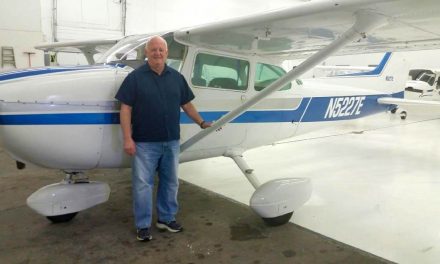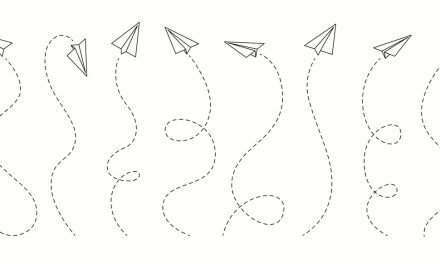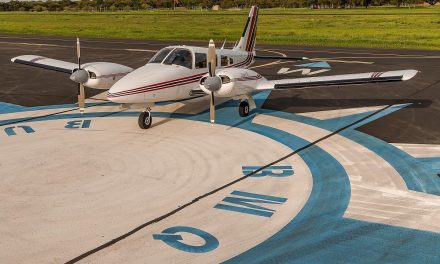
Photo courtesy of Wikimedia Commons
Angel Flight
For thousands of people across the U.S., getting access to specialized medical care means traveling hundreds of miles by car. Some go even farther relying on airline travel to transport them across the country. Coordinating these travel arrangements adds to an already stressful situation. The regional organizations that make up the Air Charity Network are working to alleviate some of that burden.
Angel Flight Southeast is one of seven organizations in the Air Charity Network that provide free flights in general aviation aircraft for patients in all 50 states.
“We arrange flights for kids, adults, and veterans who need very important lifesaving medical treatments, and typically they’re very far away from home,” said Angel Flight Southeast Associate Development Director and Event Specialist Danny Flores. “To give you an example … it’s [a] 2-year-old … living in Palm Harbor that needs to go to Miami to get a liver transplant just so he can stay alive. … When you see a 2-year-old that needs a kidney transplant or a liver transplant, or a 2-month-old that has leukemia and needs to be treated, I can’t even imagine what these families go through.”
Angel Flight Southeast and Mercy Flight Southeast together cover Florida, Georgia, South Carolina, Alabama, and Mississippi as well as the U.S. Virgin Islands, the Bahamas, and Puerto Rico.
“Angel Flight Southeast and Mercy Flight Southeast are one,” Danny said. “The Air Charity Network is made up of thousands and thousands of pilots. The organizations, our sister organizations … we’re all operating under the same network.”
Organization member Rob Garrett volunteers with one of those sister organizations in northeast Texas, through Angel Flight South Central. Since he began working with Angel Flight in 2014, Rob has flown 135 missions.
“Every flight is a story,” he said. He added that his favorite part of volunteering is the people. “Especially when you are providing transportation home and they just received a cancer-free report from their visit. They have been given a life extension!”
Angel Flight missions are designed to provide transport to scheduled appointments and treatments as opposed to providing medical transport. For this reason, requests for Angel Flights come well in advance of the day of transport and are posted to an online system accessible by the volunteer pilots.
“[The pilots] see the missions that are coming up and they volunteer for them,” Danny said. He noted that because pilots select their missions, it’s easy for them to choose the ones that best suit their aircraft.
“You are provided a multitude of missions to choose from,” Rob said adding that flying a mission for Angel Flight provides a great alternative to “having to look for a place to go for that next $100 hamburger!”
Read more stories from our members in the May issue of PIPERS magazine.
Air Charity Network organizations handle more than 40,000 requests per year, so there’s always a need for volunteer pilots. Rob encouraged fellow pilots to sign up to give themselves a reason to fly regularly.
“If you are a pilot, you need to exercise your aircraft and yourself to stay current and safe,” Rob said. “Angel Flight provides that mission helping a person in need.”
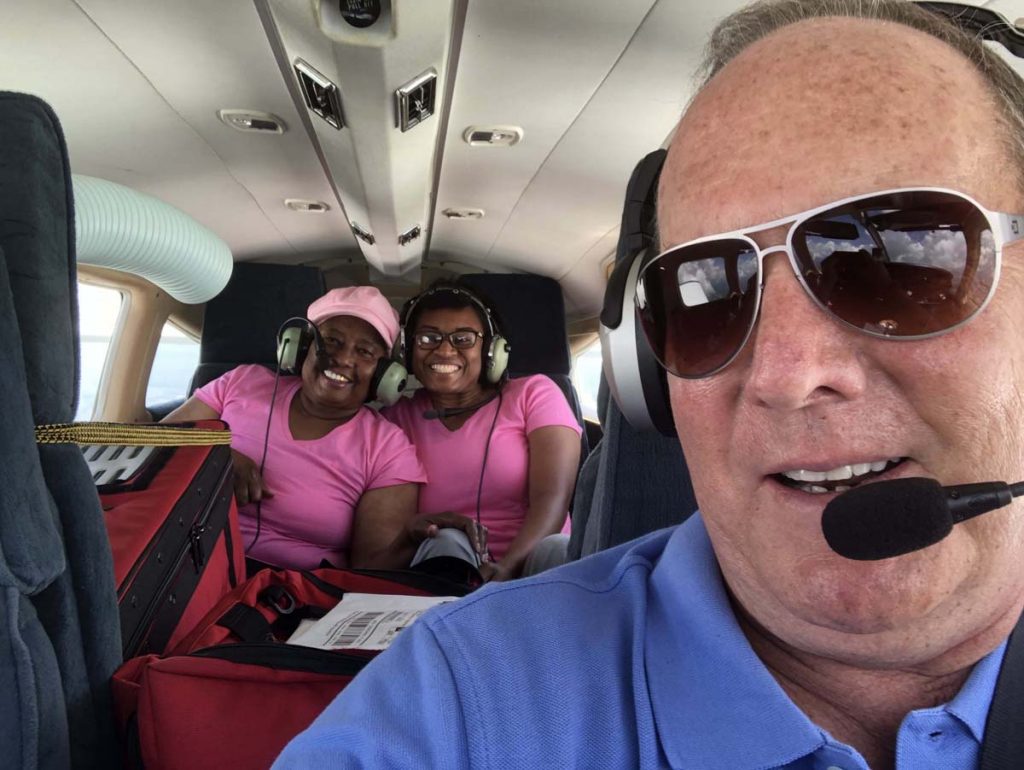
Photo by Steve Schoettle
Angel Flight Southeast pilots are required to have at least 250 hours of PIC time and $500,000 minimum in liability insurance coverage. In addition, there are requirements for the passengers themselves.
“The passenger has to be healthy enough to get themselves on the plane and to be medically released by their primary physician to make sure that they’re OK to get on the plane,” Danny said. Some members of the Air Charity Network also require that requests for flights be made by a healthcare professional while others will accept requests from the patient or their family.
Although each organization acts as its own entity, when passengers need transportation across regions, they work together coordinating legs of around 300 miles. Sometimes, a portion of the mission will be completed on the ground through the Earth Angels segment of the organization.
“We’re in the process of creating a more efficient Earth Angels program,” Danny said. “They’d be able to coordinate from the airport to the medical facility that they’re going to.”
The network already has thousands of volunteers, but Danny said that there is always room for those who are interested in helping.
“The pilots first and foremost, they want to dedicate their time,” Danny said. “We also do outreach to recruit more pilots so there’s different events that we go to to recruit and oftentimes it’s word of mouth. … It’s a big community but it’s all intertwined. There’s always medical treatment that needs to happen somewhere.”
At press time, there were 650 missions across the country waiting for a pilot.
“I am blessed with having the ability to own my own personal aircraft and want to do good things with it,” Rob said. “And what is so amazing with this organization is that the passengers are meeting a total stranger, have no idea my background or abilities, don’t know the airplane and its history, or understand the ATC system they are about to experience. That is their same experience with cancer — not knowing the doctor, the hospital, the treatments, or the outcome. Yet they blindly go on faith.”
Find out more on Air Charity Network’s website and select your region.
Challenge Air
In 1993, Rick Amber created Challenge Air as a way to help others, particularly children, overcome their disabilities in the same way that he had. Rick became a quadriplegic in 1971 after his jet crashed while attempting to land on an aircraft carrier. He was able to overcome his disabilities through a number of activities and eventually returned to flying. The idea for Challenge Air took off after he invited a group of physically disabled children for a flight. Today, the organization continues his legacy by offering free flights in GA aircraft to children and young adults — ages 7-21 — with disabilities.
“The mission of the organization really is to give kids that have special needs kind of a different perspective on life through flying,” said organization member Chris Kirk who has been volunteering with Challenge Air for nearly a decade. “We let them see beyond or through their perceived disabilities by allowing them to co-pilot an airplane.”
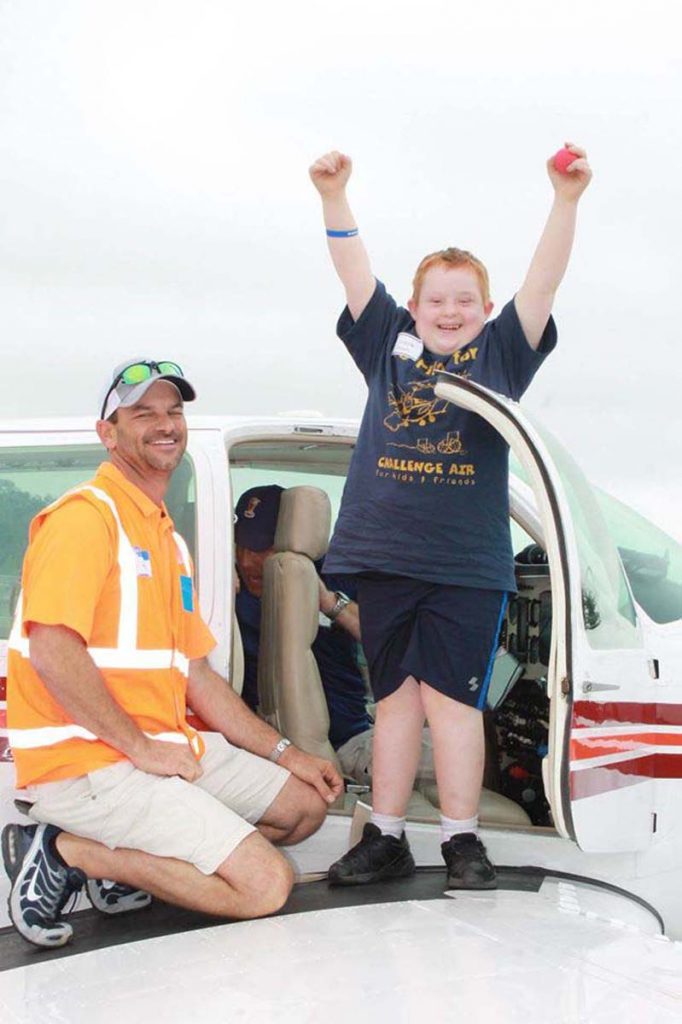
Photo Courtesy of Challenge Air
“I took this, he was probably 8, this autistic boy flying, and he was funny because he comes up to me and he goes ‘Are you my pilot?’ And I was like ‘Yeah,’” Chris said recounting a particularly memorable flight at a Fly Day in McKinney, Texas. “We flew and this kid was just living it up and just having a fantastic time. And we get on the ground and … his dad pulls me aside and he starts crying and he says, ‘You don’t have any idea what this means. My son has got so many drugs that he’s gotta take for his autism that he’s usually just numb to what goes on around him.’ And he said, ‘This — we will never forget this. And it made such a difference to him and it made such a difference to us just to see him loving something.’”
Challenge Air Executive Director and CEO April Culver said around 50% of participants fall somewhere on the autism spectrum, but the organization also works with agencies serving a variety of cognitive and physical disabilities to bring in new passengers.
“We reach out to any organization in that city that we’re serving that might be an agency for families with special needs,” she said. “Any association or society: school for the blind, Cerebral Palsy Association, Spina Bifida Association, or Down Syndrome Guild. When we decide to go to cities, we recruit volunteers that then help us reach out to those agencies that provide services to kids.”
Participants in Challenge Air’s Fly Days are encouraged to bring a friend or sibling along for the flight and April said she’s seen the effect that Challenge Air flights have on the entire family
“We had a mom send us a letter a couple of years back that her son that had Down syndrome flew with his brother,” April said. “The brother was actually two years older than his little brother with Down syndrome. He had never flown in an airplane before. … He went on and became a pilot and went to Embry-Riddle and got his pilot’s license as a sibling of one of our participants. But it was that experience that really lit his fire for aviation. He got a scholarship to Embry-Riddle and he wrote about his experience flying with his little brother with Down syndrome as his entry essay to get into college for Embry-Riddle. I had never thought about that. We always think about affecting the kids with a special need, but I never thought about affecting the siblings.”
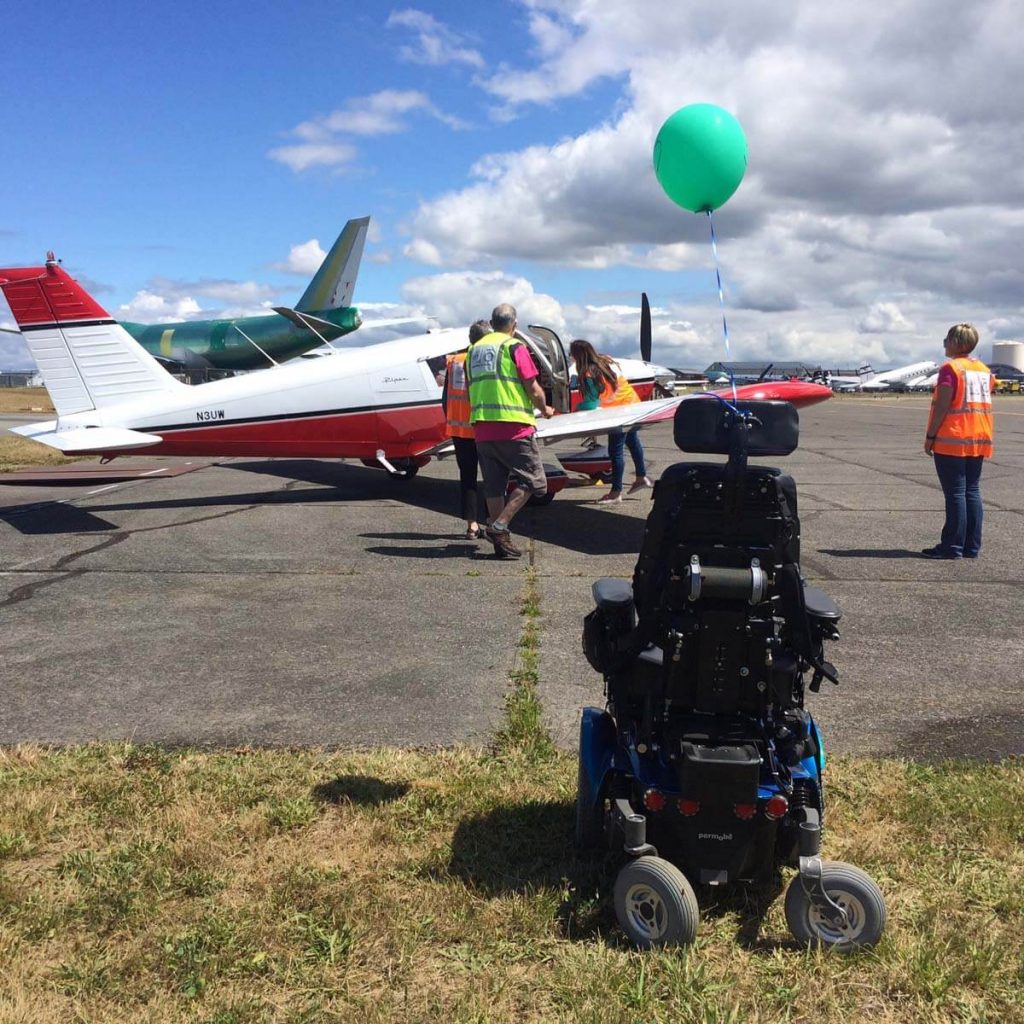
Photo courtesy of Challenge Air
In addition to the ground school and flight, each Fly Day event includes a variety of on-the-ground activities.
“We offer activities for the kids to do while they’re waiting for their flight,” April said. “We’ll get agencies in the community … that provide activities so the kids can do something while they’re waiting.”
April said that activities vary from one city to the next but often include coloring stations, craft projects, and visits from the local fire department or McGruff the crime dog.
“Every city has their own unique personality,” she said. “Up in Seattle they do a cake walk. In Oregon they give away stuffed animals for all the kids. So, it’s just different things for every city. Whatever they come up with.”
Each city that hosts a Fly Day creates a committee that handles contacting local social organizations to host activities, fundraising, and recruiting pilots and ground volunteers from the local area.
“The FBO and the airport, they usually have a pilot’s association associated with that airport and so we start there,” April said. “And then we usually have a chief pilot at every city and so that volunteer reaches out to the pilot clubs.”
In addition to local pilots, April said that about a quarter of the pilots at a given event will be from another city. In some cases, they’re flying long distances just to participate. Chris said that one of the pilots at his local Kansas City, Missouri, Fly Day comes all the way from Minnesota every year.
“When people start volunteering, they come back,” April said. “A lot of times they can’t come back every time, but they might come back every other year.”
Although Challenge Air has a dedicated group of volunteers in the cities they already host events in, April said that they’re always looking for new volunteers and new locations.
“Go to the website and see if we have an event in your city or near where you live and then just sign up to volunteer,” April said. “If they really get passionate about it and we’re not in their city, we’re always adding new cities every year, so we’d love for them to reach out and find out what it takes to host an event and maybe bring Challenge Air to their city.”
Chris said that one of the benefits of the Fly Days is they provide an opportunity to share GA with the community. Plus, it’s a rewarding endeavor.
“I think probably like most volunteers we always say that we get more out of it than they do. Just seeing these kids and seeing their families and the smiles on their faces,” Chris said. “They’re just happy and you can just see the excitement like ‘Hey, I did something new. I did something different.’ They just want to run out and tell somebody, ‘Hey, this is what I did.’ And that’s really cool.”
Find out more on Challenge Air’s website.
Pilots N Paws
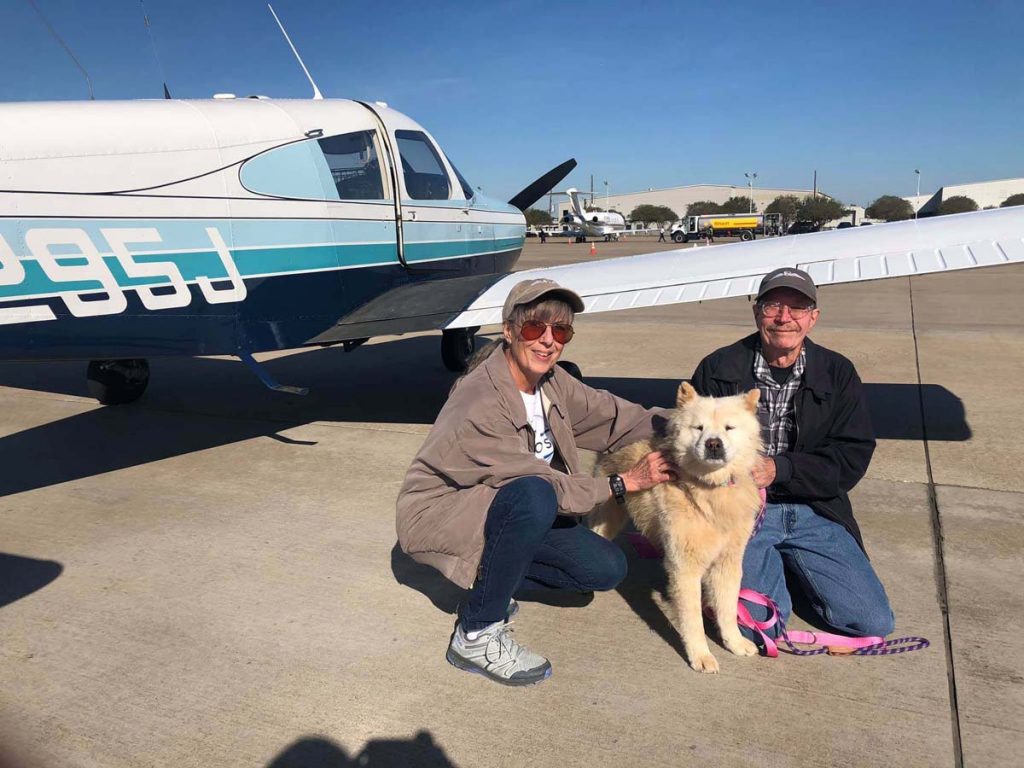
Photo courtesy of Susan Haas
For more than a decade, Pilots N Paws has been connecting pilots with animals at overcrowded shelters around the country that are in need of transport to a no-kill shelter, foster care, or their new home.
The organization started when Debi Boies asked her pilot friend Jon Wehrenberg to help her fly a rescued Doberman from Florida to South Carolina, which saved the dog’s life.
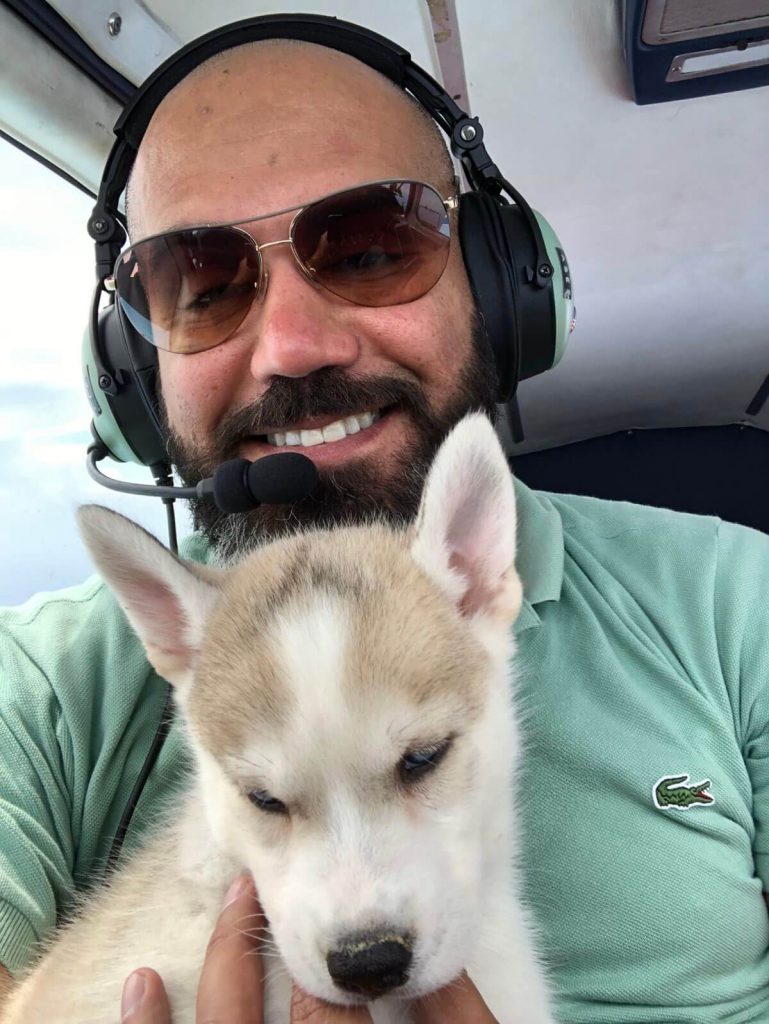
Photo by Elio Abiakel
Since then, Pilots N Paws has grown to a network of 5,000-plus volunteer pilots including organization member Elio Abiakel.
Elio began volunteering with Pilots N Paws when he was working on his airline transport pilot certificate.
“I had to build flight time … and decided to volunteer for PNP missions in order to give my cross-country flights a noble purpose, rather than just fly around the country aimlessly,” he said. “I learned about PNP from a couple of fellow pilots and we teamed up to rescue dogs across the country!”
According to the ASPCA, about 1.5 million unwanted animals are euthanized each year in the U.S. largely due to overpopulation of domestic animals.
“When you see some of the stories of the high-kill shelters, especially down South, it breaks your heart,” said organization member and PNP volunteer Joe Marsala. “I just want to do what I can to help save dogs and help the overpopulation of dogs and cats.”
Pilots N Paws’ online forum allows the more than 8,000 rescue volunteers to post information about animals in need of transport. This includes the type and size of the animal, any special needs such as an injury, the origin, and the destination. Pilots then volunteer for the flight based on their own schedules and can coordinate with others for additional legs.
“The best thing about working with PNP is the internet forum where people can view missions on a map and select the legs they would like to fly,” Elio said. “PNP’s IT, scheduling, and coordinators are all excellent.”
Each PNP mission is different, and there are a number of considerations to be made including ensuring the animals are able to be transported safely in a carrier or secured via a pet harness and seat belt; whether animals being transported together will be able to safely and calmly share space in the aircraft for the duration of the flight; and ensuring the USDA requirements for traveling with pets are met.
Pilots N Paws missions vary from local hops to cross-country hauls, but the organization’s system of connecting rescue volunteers on the ground with pilots allows for a good amount of flexibility.
“Start with small legs and learn along the way,” Elio said. “Then try to pick up whole round-trips if you’re able. It is extremely rewarding and much easier to coordinate.”
Read more stories from our members in the May issue of PIPERS magazine.
Joe said he’s flown about 40 missions with Pilots N Paws and chose to work with the organization because of his love of and connection with animals.
“Being an animal lover, it’s a natural fit for me,” he said. “It gives me a reason to fly. I love flying cross-country and it keeps my skills up and current.”
Elio said that in addition to helping him build time, he also chose to volunteer with PNP to allow him to spend time around dogs and learn more about different breeds and behaviors.
“It was always incredible to watch how the dogs appreciated what we did and how attached they became,” Elio said. “What never ceased to amaze me is their docile attitude in the airplane as well as their ability to hold their bladders for 6-plus hours!”
Although Elio and Joe said most of the missions they’ve flown have been with dogs or cats, PNP provides life-saving transportation for any animal that can be transported by plane, including dogs, cats, pigs, reptiles, and rabbits. To date, they’ve helped save more than 200,000 animals.
“For the money you spend cruising around for an hour or doing a breakfast flight, you can help an animal in need,” Joe said. “Just do it.”
Learn more on Pilots N Paws’ website.
EAA Young Eagles
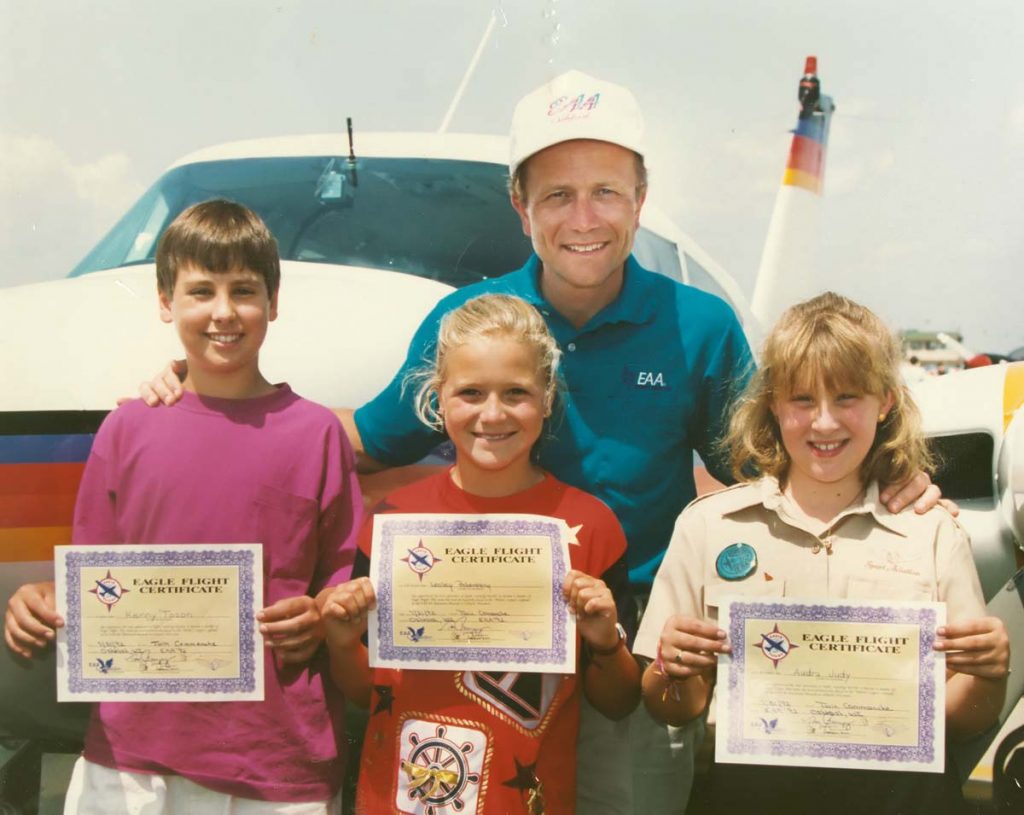
Photo courtesy of EAA
When it comes to general aviation outreach, one of the most successful programs out there is arguably EAA’s Young Eagles program. Started in 1992, the program was designed to get young people between the ages of 8 and 17 interested in aviation.
Today, pilots across the United States, and in several countries around the globe, dedicate their time to flying Young Eagles. One such pilot is organization member Jim Hantschel who flies Young Eagles with EAA Chapter 838 in Racine, Wisconsin, but his introduction to the program was somewhat rocky.
“I kind of got shamed into it,” Jim said with a chuckle. “Like a lot of guys, I was too broke or too tired or didn’t want the responsibility. About ’94 or so, I showed up one time just to see what was going on and it looked really interesting.”
At that rally, Sam Johnson, former CEO of SC Johnson, was the only pilot flying Young Eagles.
“There were like 30 kids, and I was so embarrassed,” Jim said. “We’ve got about 120 members in our group and nobody could help him out. I kind of decided I would try and get involved.”
Since then, Jim has flown more than 1,000 Young Eagles each of which, he said, has been a rewarding experience.
“Every kid is different,” he said. “Some of them … we call it our Great America ride; they just want to do something and then they’ll move onto the next thing. There’s a few of them that’ll tell you it’s the most exciting thing they’ve ever done. So those are the ones that are fun. … We will let them take the controls a little bit if they want to try it. There’s been a couple times when they’ve said I don’t want to touch this thing and then a half-hour later they’re flying.”
Jim said that at his chapter’s Young Eagles rallies, they will often have 40 kids show up hoping for a ride so there’s always a need for volunteer pilots. Often, pilots will take as many Young Eagles as their plane can safely hold but both Jim and Young Eagles Program Manager Brian O’Lena said the program works best one-on-one.
“We’d rather you fly one — it’s the best way to do it and the best way to give a flight,” Brian said. “It’ll be a great experience and to share your love of aviation is really cool. And sometimes it’s easiest to start with someone you kinda know. Maybe a friend of your kids’ or someone you know from work or church or school that you wanna take flying. Give ’em a flight and introduce ’em to aviation. Most kids have still never been in a general aviation aircraft.”
Like Jim’s “Great America ride” flights, Young Eagles are oftentimes looking for something fun and different to do, but other times the flight instills an interest in the aviation world that translates into a career down the line.
“I’ve got three now that are already in flight training,” Jim said. “One of them just got his license; two others have soloed. I’ve got one in the Marines — he’s a helicopter mechanic. I’ve got one flying fighters. I wish I could keep track of everybody. I’m sure there’ll be a lot more pilots.”
Although creating a future pilot is the ultimate goal of a Young Eagles flight, Jim spoke about the confidence boost the program provides, especially for young girls.
“We fly about 50/50 girls and boys and I’ve had girls say, ‘I can’t do this. I’m a girl,’” he said.
“It’s more than sad — it’s like the worst thing you can hear out of the mouth of a kid, I think. If you can get somebody like that to take the controls for a few minutes and do some turns and some simple maneuvers, it does a lot for them and it does a lot for us, too.”
Most Young Eagles pilots you’ll talk to share Jim’s sentiment — they get a lot from the program, but mostly it’s about giving back.
“Wanting to give back to aviation and wanting to share their love of aviation,” Brian said of the reasons pilots volunteer with Young Eagles. “I think it’s a pilot always wanting to share their love of flight with someone else and who better than the next generation?”
Brian said that each year 4,600-5,000 EAA members volunteer to fly Young Eagles, but there’s always room for more. Jim shared some advice for anyone who’s on the fence like he was back in 1994.
“The advice I would give is just to try it,” Jim said. “Just try one and see how it goes. I think they’d enjoy it. … My advice if they don’t want to fly right away … show up at a Young Eagles rally and just see what’s going on.”
Jim also noted that Young Eagles are better and more enjoyable for pilot and passenger when flown from a familiar airport on a great weather day.
“We’ve all got our personal limits,” he said. “With Young Eagles it’s a little bit less. We don’t like to go when it’s windy. I hate disappointing kids when they show up for it. We do a little ground school for them and they show up and spend an hour and a half to two hours at the chapter and then we tell them we can’t go, it’s very disappointing.”
When that happens, Jim said he’ll reschedule as many flights as he can.
The Young Eagles program is now almost 30 years old, but it is still evolving and growing.
“We’re more than a flight now,” Brian said. “It used to be just the Young Eagles flight and now we’ve got the Young Eagles Flight Plan … the student membership, the free Sporty’s course — we’re going to hit 75,000 this month enrolled in Sporty’s … taking the private pilot course. We’ve got the free flight lesson. Every week we reimburse kids for a free flight lesson that have completed the Sporty’s course. We’ve got the scholarships and lately we’ve had the Ray Aviation Scholarships, which is over $1 million in flight training scholarships every year given to Young Eagles. We’re adding more all the time.”
Find out more on EAA’s Young Eagles page.

